Japanese educational card games offer a unique blend of fun and learning, making them an engaging tool for students of all ages. Rooted in traditional Japanese culture, these games not only enhance cognitive skills but also promote teamwork and communication. With vibrant illustrations and innovative gameplay mechanics, they provide an interactive way to master various subjects, from language acquisition to mathematics. In this article, we will explore the history, types, and benefits of these educational tools, showcasing how they can transform the learning experience in classrooms and homes alike. Join us as we delve into the fascinating world of Japanese educational card games!
Want to learn the Japanese arts, language & culture?
*Check our fun & creative learning resources now!
*Choose our durable, functional & attractive original products!
*Conversation starter or Ice-breaker topics on Japanese, English, Math, Social Studies, History, Arts, etc.
*Great souvenir gift for family, loved ones, friends & guests!
*Congratulatory presents to students & colleagues!
*Promo school & company giveaways!
*Lasting game prizes!
*A beautiful reminder of your time in Japan!
*Great way to learn culture & language — the OIJs (Origin in Japan/Only in Japan!)
*Enjoy the unique Japanese arts, language & culture through the educational games!
An original product. It features 5 attractive color packaging representing unique Japanese food (red/kurenai), Japanese costumes (blue/ai), Japanese nature (green/matsuba), Japanese sports, games & entertainment (purple/fuji), and the 4 seasons in Japan (pink/sakura). A site link gives detailed information per image that leads you to a deeper understanding of the culture. Japanese style design perfect for learning and teaching the Japanese language, arts, sports, and history. Good learning material for different subjects like English, Japanese, Math, History, Social Studies, and Literature. Great souvenir from Japan. A popular gift for family, friends & acquaintances!
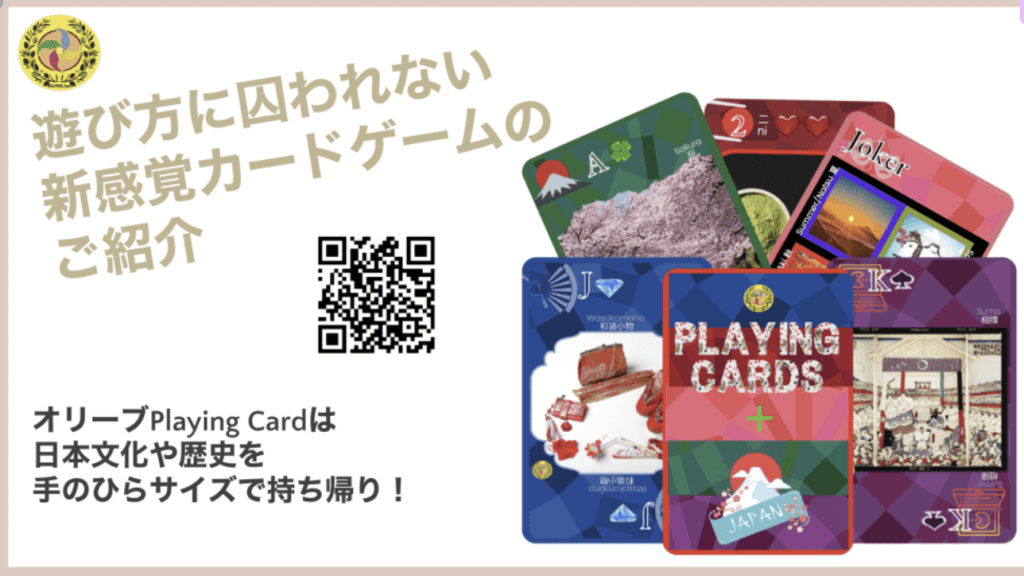
Design: Inspired by OIJs (Origin in Japan/Only in Japan) that the creator gathered in her 30+ years as a foreign teacher in Japan. Her Japanese students researched and presented in class what makes their country unique. One of the adult students assisted in the completion of this long-overdue educational project. Foreign residents and tourists are fascinated with the unique Japanese arts, language, and culture. Aim to showcase the unique Japanese culture to the world through the Olives Playing Cards+Japan and Olives Uno+Japan Cards.
Fun educational games for all ages and nationalities. The site links you to 55+ suggested games using the 2 decks of cards. 100% Professional Grade. 250gsm copper card paper, double-sided printing with a glossy finish on the surface. Olives Playing Cards+Japan deck contains 52 poker cards & 2 Joker cards. Olives Uno+Japan Cards deck contains 108 playing cards (25 cards per color & 8 Wild cards). Japanese design perfect for overseas souvenirs. Popular gifts from Japan for foreign friends!
| Number | Olives Playing Cards+Japan | Red (Kurenai) | Blue (Ai) | Green (Matsuba) | Purple (Fuji) |
| *Click the name for detailed info. | Food | Costumes | Nature | Sports, Games & Entertainment | |
| 1 | A | Onigiri おにぎり | Maiko 舞子 | Sakura 桜 | Nimonnoanime 日本のアニメ |
| 2 | 2 | Maccha 抹茶 | Nihongami 日本髪 | Kiku 菊 | Janken ジャンケン |
| 3 | 3 | Tenpura 天ぷら | Randoseru ランドセル | Shibazakura 芝桜 | Kendo 剣道 |
| 4 | 4 | Shakeikuradon 鮭いくら丼 | Yukata 浴衣 | Asagao 朝顔 | Igo 囲碁 |
| 5 | 5 | Hinomarugohan 日の丸ご飯 | Miko 巫女 | Fujinohana 藤の花 | Koma こま |
| 6 | 6 | Oden おでん | Yomeiri 嫁入り | Tsubaki 椿 | Origami 折り紙 |
| 7 | 7 | Shabushabu しゃぶしゃぶ | Meido メイド | Kinmokusei 金木犀 | Bacharugemu バーチャルゲーム |
| 8 | 8 | Misoshiru 味噌汁 | Rorita ロリータ | Tanpopo たんぽぽ | Mochitsuki 餅つき |
| 9 | 9 | Soba 蕎麦 | Furoshiki 風呂敷 | Momiji 紅葉 | Otedama おてだま |
| 10 | 10 | Onigiri おにぎり | Geta 下駄 | Shiragiku 白菊 | Gemu ゲーム |
| 11 | J | Kakigori かき氷 | Wasokomono 和装小物 | Nihonteien 日本庭園 | Karate 空手 |
| 12 | Q | Taiyaki たい焼き | Obi 帯 | Bonsai 盆栽 | Hinaningyo ひな人形 |
| 13 | K | Sushi 寿司 | Shichigosan 七五三 | Ikebana 生け花 | Sumo 相撲 |
| Joker (2) | Pink(Sakura) | ||||
| Seasons in Japan | |||||
| 1 | Spring/Haru 春 | ||||
| 2 | Summer/Natsu 夏 | ||||
| 3 | Autumn/Aki 秋 | ||||
| 4 | Winter/Fuyu 冬 |

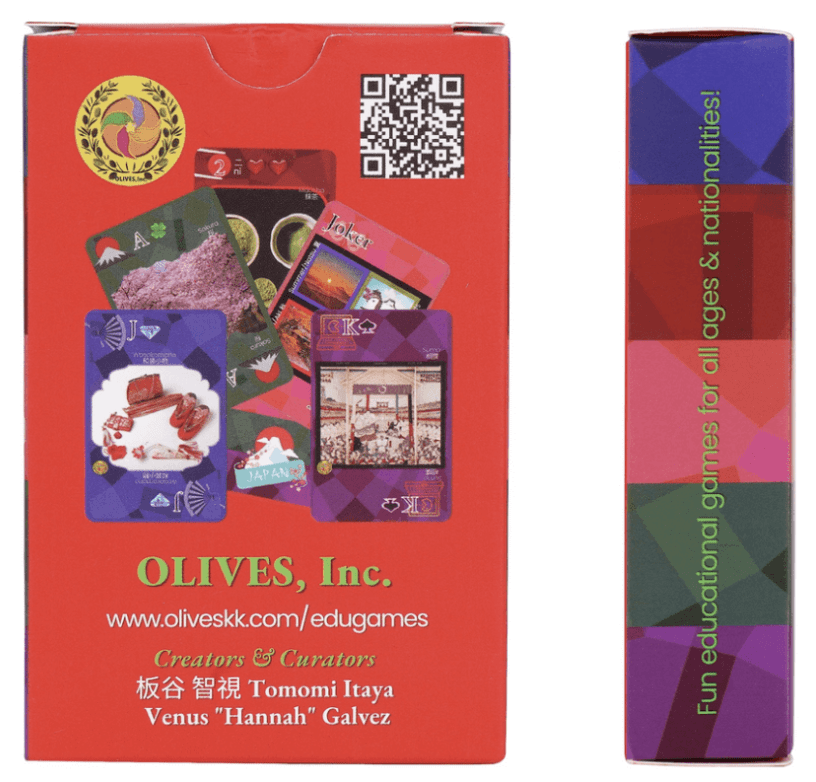
| Suggested Card Games | *Click the names for game details. | ||||
| 1 | Beggar My Neighbour | 12 | My Ship Sales | 23 | Speed |
| 2 | Cheat | 13 | Old Maid | 24 | Spit |
| 3 | Concentration | 14 | Peanut Butter/Kemps/Cash | 25 | Snap |
| 4 | Crazy Eights | 15 | Pig | 26 | Snip, Snap, Snorem |
| 5 | Egyptian Ratscrew | 16 | President | 27 | War |
| 6 | 52 Pick Up | 17 | Put | 28 | Give Me What I Want (Cards Hunt) |
| 7 | Go Fish | 18 | Rolling Stone/Enfle | 29 | 7 Bridge (Shichinarabe) |
| 8 | House of Cards | 19 | Rummy | 30 | Memory Game (Shinkeisui Jack) |
| 9 | Lucky Seven | 20 | Seven Bridge | 31 | Babanuki (Old Maid) |
| 10 | Marriage | 21 | Solitaire | 32 | 7-5-3 (Shichi-Go-San) |
| 11 | Lucky One/ ~ 13 | 22 | Jijinuki (Old Bachelor) | 33 | Cards Shoot/Furthest Reach |
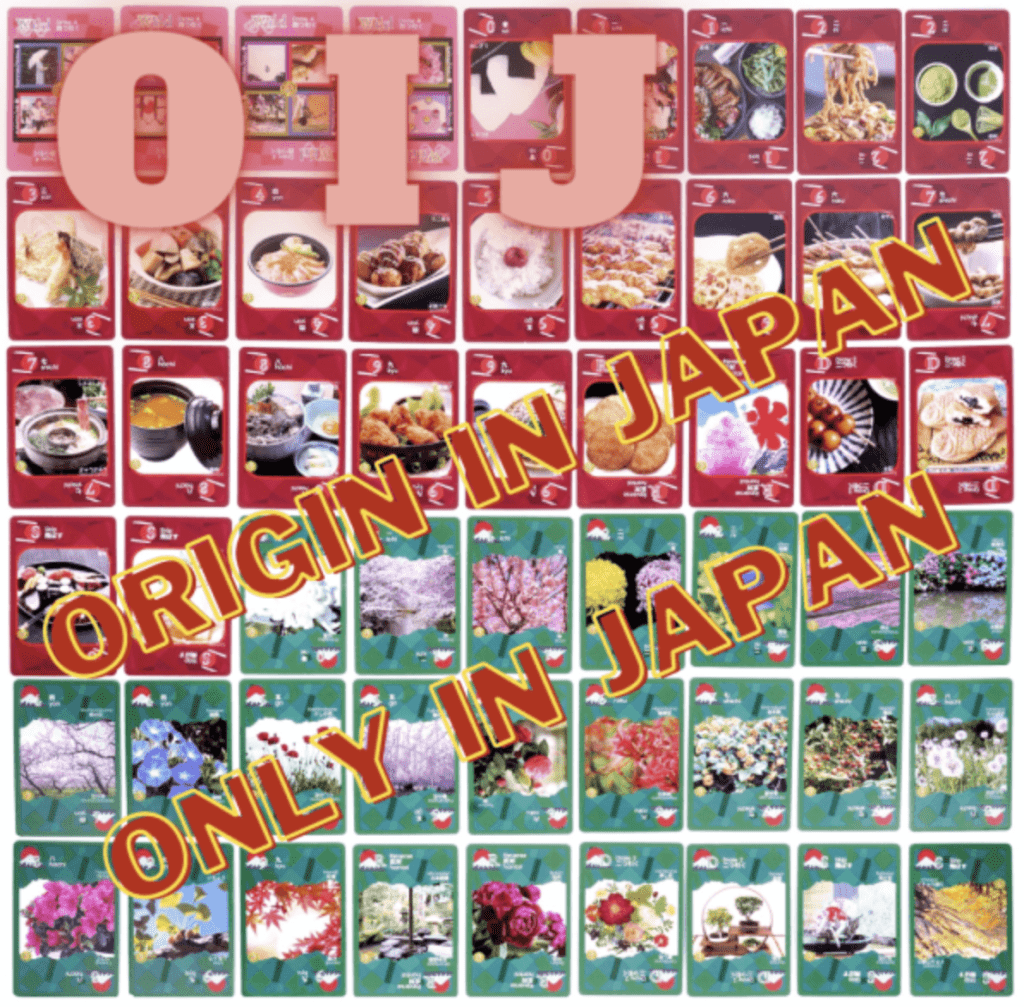
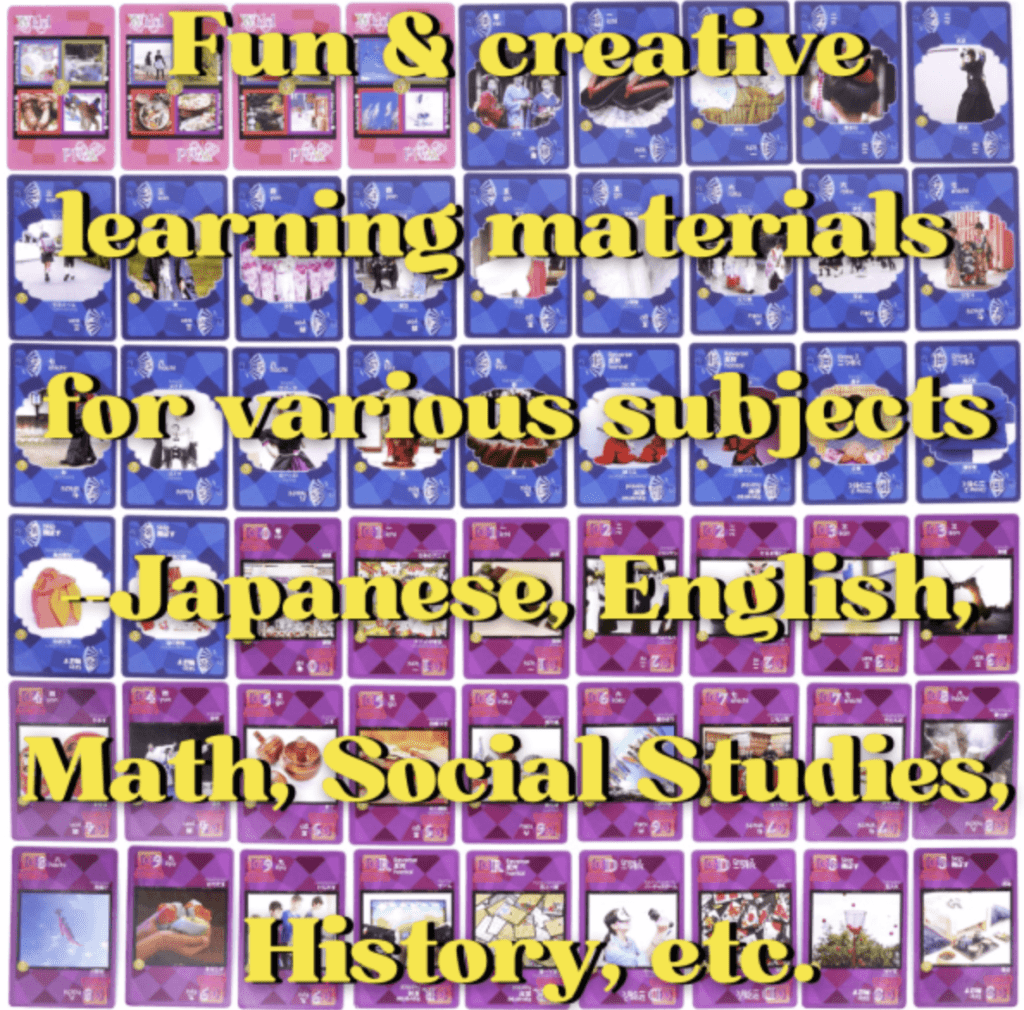
| Wild (8 cards) | Pink(Sakura) | |||
| Seasons in Japan | ||||
| Wild and Wild Draw 4 | Spring/Haru 春 | |||
| Wild and Wild Draw 4 | Summer/Natsu 夏 | |||
| Wild and Wild Draw 4 | Autumn/Aki 秋 | |||
| Wild and Wild Draw 4 | Winter/Fuyu 冬 | |||

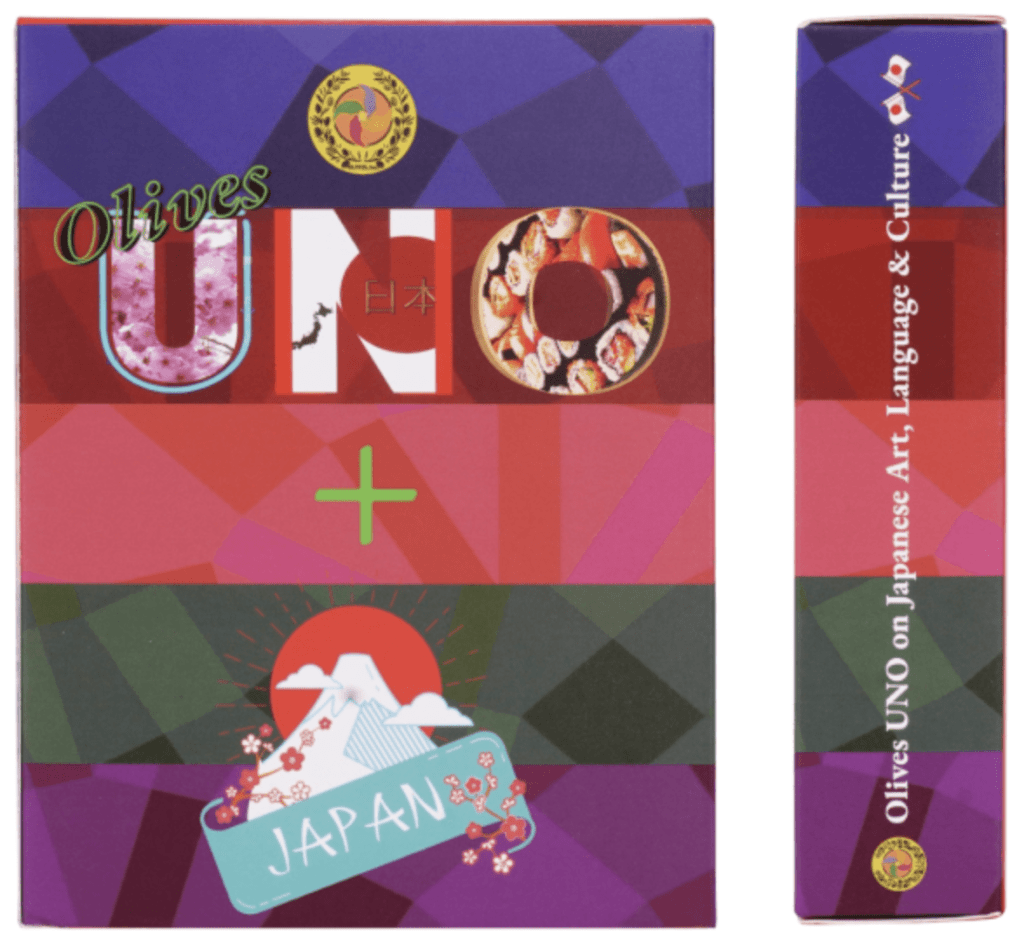
Suggested Card Games | |||||||
1 | Card Houses | Players: 2 players. Ages: Pre-teens + Teens. Time to Play: 10 minutes. | Split the deck of cards into 2 and hand each deck to the players. Set a 10 minute timer and challenge both players to build the tallest tower within the time limit. The player who builds the tallest, most secure tower wins. | ||||
2 | Card Toss | Players: 2+ players. Ages: Younger children. Time to Play: 5 – 20 minutes. | Cards move very differently through the air than a ball, which makes them fun to toss. Set up any kind of container and see who can toss the most cards into it! | ||||
3 | Card Constructions | Players: Individual or group. Ages: All ages. Time to Play: 5 – 20 minutes. | |||||
4 | Color & Match Game | Players: 2+ players. Ages: Younger children. Time to Play: 5 – 20 minutes. | Color + Number Match in a nutshell: Sort through all the cards, so you only have the colored number cards in a deck. Also, make sure your child has plenty of different colored items such as candy. Then, draw a card from the pile, the player needs to place the items which match the amount and color that is on the card. | ||||
5 | Construction Set | Players: 2+ players. Ages: Younger children. Time to Play: 5 – 20 minutes. | Adding a set of cards to other building materials can be lots of fun. Try adding Uno cards, plastic cups, and craft sticks to make a fun construction set. Or simple add cards to regular wooden building blocks or another construction set for an added dimension. | ||||
6 | Domino Effect | Players: 2+ players. Ages: Pre-teens + Teens. Time to Play: 20 minutes. | Start by dividing the deck of cards in half and handing it to each player. Set a 20-minute time limit, and each player needs to make the longest ‘domino train’ possible. The player with the longest train wins. | ||||
7 | Find It | Players: 2+ players. Ages: Younger children. Time to Play: 5 – 20 minutes. | Use number cards in all colours, starting with just low numbers. When you turn over a card, you have find, or list things, that number of objects in that colour. Eg if you turn over a green 3, you need to run around and find 3 green things, or list three green things you can see. | ||||
8 | Find The Items | Players: 2 – 5 players. Ages: Children + Pre-teens. Time to Play: 5 – 15 minutes. | Grab all of the number cards and shuffle them/ Draw a card from the pile. Players need to find as many items in the color of the card that is on the card. So if a ‘Red 4’ gets drawn then, players need to find 4 red items. A point gets awarded to the first player to complete each challenge. Most points at the end of the game wins. | ||||
9 | Go Fish | Players: 2 – 5 players. Ages: Children + Pre-teens. Time to Play: 5 – 15 minutes. | Remove all cards except 2 of each color number. Shuffle and deal out 7 cards evenly to players. Players need to match 4 cards that are the same, and they ask the other players if they have any cards that they need to complete a set of 4. If they do not have the card, they get told to ‘Go Fish’, and the player picks up another card. The first player to get rid of their cards wins. | ||||
10 | Guess The Number | Players: 2+ players. Ages: Children, Pre-teens + Teens. Time to Play: 5 – 15 minutes. | Shuffle the entire cards deck and hand out a card to each player. Players need to stick their given card to their forehead without seeing what card they have. They then ask questions to try to figure out what card they have on their forehead. Other players can only answer ‘yes’ or ‘no’ questions. The player that correctly guesses their card in the fewest number of questions wins. | ||||
11 | Higher or Lower | Players: 2+ players. Ages: Children, Pre-teens + Teens. Time to Play: 5 – 15 minutes. | Shuffle the card deck, including some but not all of the wildcards. Draw the top card. The player will have to guess if it’s higher, lower, or a wildcard up next. See how many correct guesses players can get—the player who is correct the most wins. | ||||
12 | Memory | Players: 2+ players. Ages: Younger children + Children. Time to Play: 5 – 15 minutes. | Gather together 20 cards that are in 10 pairs. Shuffle them and lay the cards out in a 5×5 grid pattern, ensuring they are in a random pattern. Challenge a player to find the 10 pairs with the least amount of moves possible. Record how many cards they overturned to complete the challenge, and the player with the lowest number wins. | ||||
13 | Move It | Players: 2+ players. Ages: Younger children + Children. Time to Play: 5 – 15 minutes. | You’ll need number cards in all colours, plus wild cards (optional), and a bit of space to play this game. Assign each colour an action, each person turns over a card and they have to do the action assigned to that colour as many times as the number on the card. If you turn over a wild the person to your left gets to pick the action and number of times you have to do it (we limit the number to the highest card we’ve included in the deck!). | ||||
14 | Number Grab Game | Players: 2+ players. Ages: Younger children + Children. Time to Play: 5 – 15 minutes. | This is a great way to work on number recognition. Using just the number cards in all colours turn over one card and the first person to say the number of the card gets to keep it. The winner is the person with the most cards at the end (counting the cards to work out the winner is another great number learning task!). To make it a little harder you can turn over two cards and the first person to say the number those two cards make up keeps both cards. eg A two and a three card would be 23. To make it even harder for older kids, turn over two cards and the first person to make a sum out of them and give the correct answer keeps the cards. eg. A two and a three card could be 2+3=5 or 2×3=6 | ||||
15 | Old Maid | Players: 2 – 5 players. Ages: Children + Pre-teens. Time to Play: 5 – 15 minutes. | Get all the number cards from a pack and 1 random wild card. Shuffle these cards and deal them out to all players. Players need to match cards, if they have a match in their initial draw, then they can put these aside. Hold up the remaining cards to the player on the right so they can pick 1 at random to potentially make another match. The player holding the wildcard at the end of the game loses. | ||||
16 | Simple Patterns | Players: 2+ players. Ages: Younger children + Children. Time to Play: 5 – 15 minutes. | The ability to recognise and create patterns is another important maths skill and Uno cards are great for playing with patterns. Set out a simple pattern for your child to continue. Start with the same number in different colours for young players, then try mixing the numbers and colours. Eg red 1, yellow 2, red 2, red 1, yellow 2, red 2, what comes next? | ||||
17 | Snap | Players: 2+ players. Ages: Younger children + Children. Time to Play: 5 – 15 minutes. | Only use the number cards, separate these and shuffle them into a deck. Place the deck face down. Deal out the entire deck to players, so they have roughly the same number of cards. Starting left of the dealer, players place 1 card onto a discard pile one at a time. When there’s a matching pair, all players need to slap their hand onto the pile and shout SNAP! Whoever’s hand is at the bottom wins that round and takes the pile. Whoever ends up with all the cards wins the game. | ||||
18 | Spoons | Players: 6 – 12 players. Ages: Pre-teens + Teens. Time to Play: 30 – 45 minutes. | Take all the number cards out of the card deck and get 1 less spoon than people playing. Players get 4 cards each, and players need to match 4 numbers. Once a player has 4 of a kind, they can pick up a spoon. The last player without a spoon gets given a letter that spells out SPOON. Once a player has SPOON, they are out. The last player remaining in the game wins. | ||||
19 | Sorting | Players: 2+ players. Ages: Younger children + Children. Time to Play: 5 – 15 minutes. | Classifying and sorting is an important skill for later mathematical thinking, and it’s also a great way to work on colour and number recognition. For little ones who are just starting to learn the names of colours, turning over a card and naming the colour you see is a simple and fun beginners activity. Then you can move on to sorting the cards into piles according to colour. You can do the same with naming and sorting numbers, and then combine both attributes and have your child sort into piles of colours and numbers. eg all the red ones, all the blue fives etc. | ||||
20 | Stacking Draw Cards | Players: 2+ players. Ages: Younger children + Children. Time to Play: 5 – 15 minutes. | Allows players to stack Draw 2 or Draw 4 cards to cause other players to draw even more cards. Three Hand Uno: Each player has three piles of cards to try to get rid of. Three Piles: Makes use of three discard piles instead of one. Time Bomb: Adds a delay to Draw 2 and Draw 4 cards. | ||||
21 | 7-5-3 (Shichi-Go-San) | Players: 2+ players. Ages: Younger children + Children. Time to Play: 5 – 15 minutes. | All cards face down arranged in circle. Each player will take turns to pick 1 card and say, “Shichi-Go-San” as s/he put the card face up in the center of the circe. If the card is either 7, 5, or 3, the fastest who can tap the face of the card will get the card or stacks of cards. The game over if all the cards were put face up. The player with the largest number of cards is the Winner. | ||||
22 | Old Maid (Babanuki) | Players: 2+ players. Ages: Younger children + Children. Time to Play: 5 – 15 minutes. | Distribute all the cards to the players except 1 Wild card. Each player puts down 2 match cards. The players will decide who will pick the card. Normally, “janken” and clockwise taking turns. The one who got the Wild card without a match lost the game. | ||||
23 | Give Me What I Want (Cards Hunt) | Players: 2+ players. Ages: Younger children + Children. Time to Play: 5 – 15 minutes. | Allows players to stack Draw 2 or Draw 4 cards to cause other players to draw even more cards. Three Hand Uno: Each player has three piles of cards to try to get rid of. Three Piles: Makes use of three discard piles instead of one. Time Bomb: Adds a delay to Draw 2 and Draw 4 cards. | ||||
24 | Cards Shoot | Players: 2+ players. Ages: Younger children + Children. Time to Play: 5 – 15 minutes. | Each player can have 10 cards. The players will take turns in shooting the cards in a basket. The one with more shoots wins the game! | ||||
25 | Fly the Cards | Players: 2+ players. Ages: Younger children + Children. Time to Play: 5 – 15 minutes. | Each player will have 1 card each. The one who can throw/fly the card the farthest is the winner! The players can decide how many times they compete or how many cards they can throw and the one with the farthest card is the winner | ||||
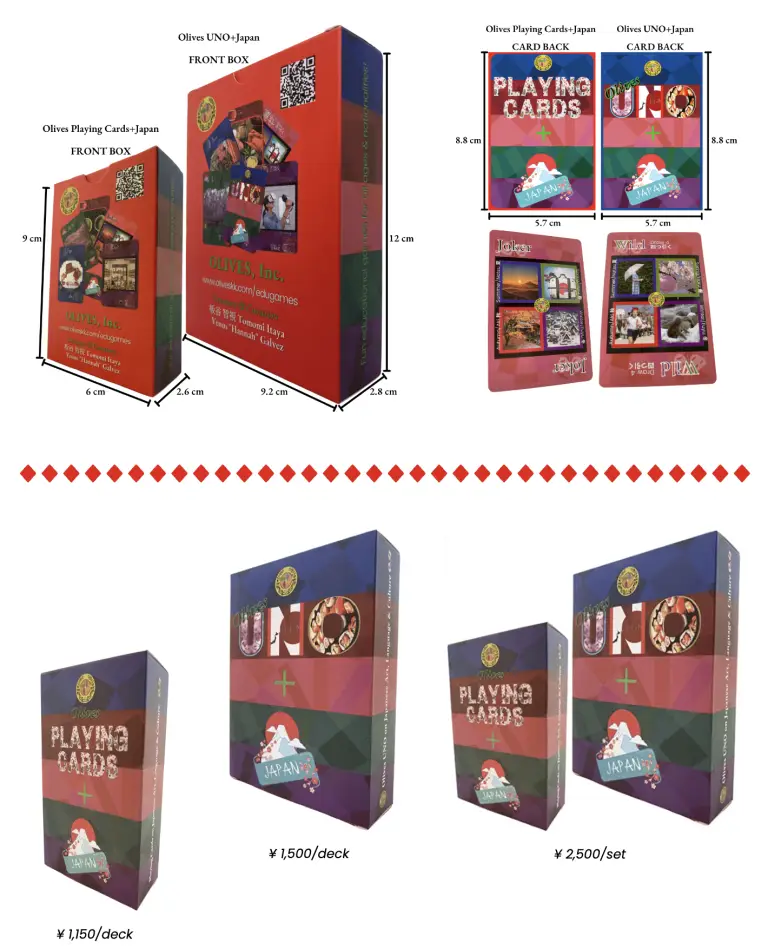
- Original product with 5 color representing Japanese themes: food (red/kurenai), costumes (blue/ai), nature (green/matsuba), sports/games & entertainment (purple/fuji), and the 4 seasons (pink/sakura)
- Japanese-style design perfect for learning the language, arts, sports, and history. Ideal for subjects like English, Japanese, Math, History, Social Studies, and Literature. Great souvenir from Japan.
- Inspired by Original/Only in Japan (OIJs) gathered during 30+ years of teaching; adult students’ research and collaboration. Showcasing Japanese arts, language, and culture to the world through Olives Playing Cards+Japan & Olives UNO+ Japan Cards.
- Fun educational games for all ages and nationalities. Japanese designs perfect for overseas souvenirs & gifts. Popular gifts from Japan for foreign friends! Learn the Japanese language & culture with the unique educational resources.
- Wonderful gift for family, loved ones, friends & guests! Enjoy the suggested 55+ educational games; check the QR Code printed in the boxes! A beautiful reminder of your time in Japan! Remember the Origin in Japan/Only in Japan in an interesting way.
- Captivating card games that bring together the essence of Japanese arts, language, and culture. Immerse yourself in the vibrant world of Japan while having a blast with family and friends
- Visual Experience with Japanese Artwork: Each card showcases exquisite Japanese art, making every round visually stunning and engaging. Discover the beauty of traditional and contemporary Japanese artwork as you play.
- Learn and practice Japanese phrases, vocabulary, and expressions effortlessly, making it an ideal educational resource for language enthusiasts of all ages. Expand your cultural knowledge while having fun!
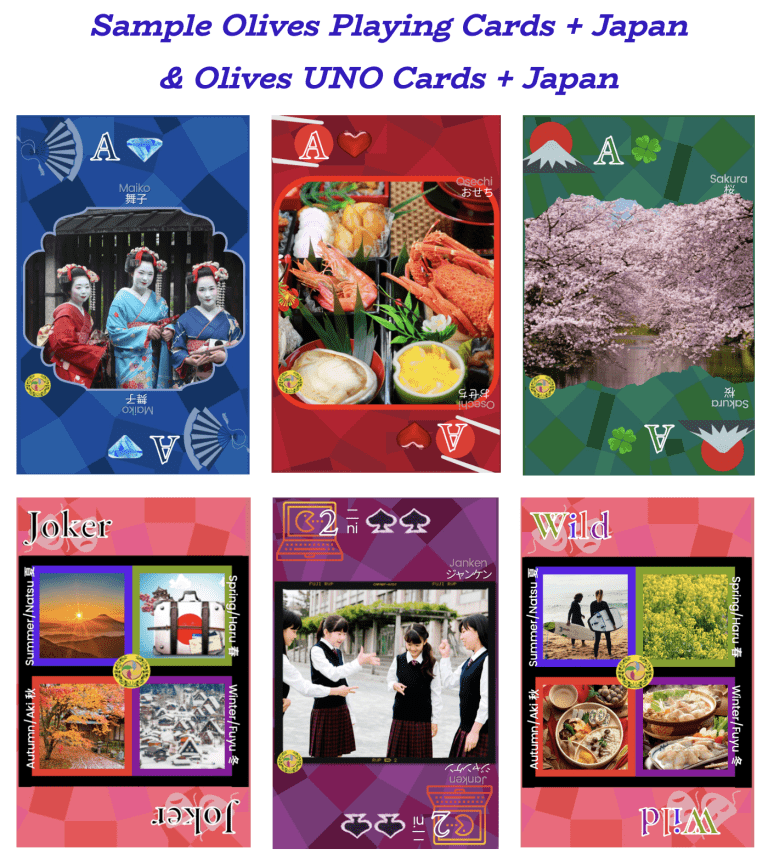
- This versatile game is perfect for various occasions, be it family gatherings, game nights, or parties. It stimulates discussions about Japanese, English, math, social studies, history, and more.
- Dive into the suggested 55+ educational learning games that enhance memory, strategy, and critical thinking skills. Entertain and educate yourself in an interactive and educational experience.
- Traditional Card Games: The Olives Playing Cards+Japan deck can be used to play classic card games like Poker, Rummy, and Bridge. The deck consists of 52 poker cards and 2 Joker cards, providing endless possibilities for traditional card game enthusiasts.

Olives Uno+Japan Cards: contains 108 playing cards, including 25 cards per color and 8 Wild cards. The gameplay follows the familiar UNO rules, where players match colors, numbers, or symbols to discard cards and aim to be the first to empty their hands. Japanese Culture Trivia: Utilize the cards as a Japanese culture trivia game. Each card represents a unique aspect of Japanese culture, such as food, costumes, nature, sports, games, entertainment, and seasons. Players can take turns asking trivia questions based on the images and information provided on the cards. Memory Match: Create a memory matching game by laying the cards facedown and taking turns flipping two cards at a time.
The objective is to find matching pairs of cards, testing players’ memory skills while exploring Japanese art and culture. Language Learning: Utilize the cards to enhance language learning. Assign vocabulary words or phrases to each card, and players take turns drawing a card and correctly pronouncing the corresponding word or phrase in Japanese or any desired language. Create Your Own Games: Let your creativity flow by inventing unique games using the cards. Combine elements from different card games, incorporate trivia questions, or introduce challenges and rules based on Japanese culture. The possibilities are endless!
Fun Educational Games for All Ages and Nationalities. There are 55+ suggested games using 2 decks of cards. Professional Grade with 250gsm copper card paper, double-sided printing, and glossy finish. Olives Playing Cards+Japan: 52 poker cards & 2 Joker cards. Olives Uno+Japan Cards: 108 playing cards (25 cards per color & 8 Wild cards). Have Fun with our Japan Souvenirs & Gifts Package #1!
Check our Amazon Store in 14 Marketplaces/Countries (Brand: OLIVES, Inc.): https://www.amazon.co.jp/stores/page/17F3FB71-6453-4F36-9DBB-66CA0C8434EE
For discount & quick delivery (1-day free delivery in Japan), you can send a private message to us
on our Facebook Page: Japan Souvenirs, Gifts & Edupreneurs
We accept retailers & wholesalers! Send message here: learn@oliveskk.com
SUBSCRIBE to Filipina Edupreneur for exclusive access to a world of inspiration, knowledge, and opportunities in Japan & beyond. Join our vibrant community and stay updated on the latest posts, tips, and special offers. Just click this link: FILIPINA EDUPRENEUR
